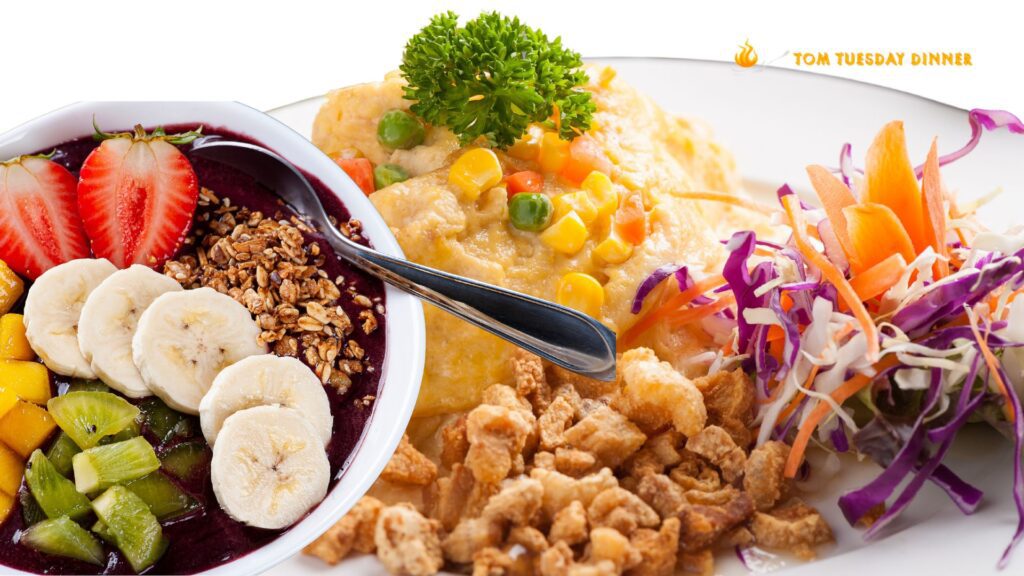We use affiliate links. If you purchase something using one of these links, we may receive compensation or commission.
How to Create Unique Flavor Combinations in Your Cooking
Have you ever wondered how to create unique flavor combinations in your cooking? Do you want to impress your guests with dishes that are delicious, creative, and surprising? If so, you are not alone. Many people love to experiment with different ingredients and spices to create new and exciting flavors.
But how do you know which flavors go well together? How do you avoid creating a dish that is bland, boring, or worse, disgusting? The answer is not as simple as you might think. There is no one formula or rule that can tell you how to combine flavors. However, there are some general principles and tips that can help you explore the world of flavor combinations and discover your own personal preferences.
The Science of Flavor
How Our Senses Work Together to Create Flavor
Flavor is not just about taste. It is a complex sensation that involves all of our senses: smell, sight, touch, sound, and even emotion. When we eat something, we perceive its flavor through the interaction of different molecules with our taste buds, olfactory receptors, and nerve endings in our mouth and throat. These signals are then processed by our brain, which creates a perception of flavor based on our memories, expectations, and preferences.
The basic tastes that we can detect are sweet, sour, salty, bitter, and umami (savory). Each of these tastes has a different function and effect on our body. For example, sweet signals energy and calories, sour signals acidity and freshness, salty signals minerals and hydration, bitter signals toxins and caution, and umami signals protein and satisfaction. However, these tastes are not enough to describe the full range of flavors that we can experience. There are also thousands of different aromas that contribute to flavor, as well as other factors such as texture, temperature, spiciness, color, shape, and sound.

The Art of Flavor
How to Use Flavor Profiles as a Guide to Create Different Combinations of Flavors
Flavor is not just about science. It is also about art. It is about creating harmony and contrast between different elements of a dish. It is about balancing the intensity and complexity of flavors. It is about evoking emotions and memories through food. It is about expressing yourself and your culture through your cooking.
There are many ways to create unique flavor combinations in your cooking. One way is to use the concept of flavor profiles. A flavor profile is a set of characteristics that describe the overall impression of a flavor. For example, some common flavor profiles are:
- Spicy: hot, pungent, peppery
- Sweet: sugary, honeyed, fruity
- Sour: acidic, tangy, citrusy
- Savory: meaty, salty, umami
- Bitter: sharp, bitter
- Herbal: fresh, green
- Floral: fragrant
- Nutty: roasted
- Smoky: charred
You can use these flavor profiles as a guide to create different combinations of flavors. For example:
- Spicy + Sweet: This combination creates a contrast between heat and sweetness that can be very appealing. Examples are chili chocolate, mango salsa, or honey sriracha chicken.
- Sour + Savory: This combination creates a balance between acidity and saltiness that can enhance the flavor of many dishes. Examples are lemon chicken, tomato soup, or pickled vegetables.
- Bitter + Herbal: This combination creates a depth of flavor that can add complexity and freshness to your cooking. Examples are kale salad, pesto pasta, or mint chocolate.
- Floral + Nutty: This combination creates a delicate and elegant flavor that can be very soothing and relaxing. Examples are lavender tea, almond cake, or rose water pistachio ice cream.
- Smoky + Sweet: This combination creates a rich and decadent flavor that can be very satisfying and indulgent. Examples are bacon maple donuts, smoked salmon with maple glaze, or barbecue sauce.
Of course, these are not the only possible combinations of flavors. You can also mix and match different flavor profiles to create your own unique combinations. For example:
- Spicy + Sour + Savory: This combination creates a bold and vibrant flavor that can be very stimulating and exciting. Examples are kimchi, hot and sour soup, or pad thai.
- Sweet + Savory + Nutty: This combination creates a cozy and comforting flavor that can be very nourishing and satisfying. Examples are peanut butter jelly sandwich, cheese cake, or granola bars.
- Sour + Bitter + Herbal: This combination creates a refreshing and cleansing flavor that can be very invigorating and energizing. Examples are grapefruit juice, green tea, or mojito.
- Floral + Smoky + Sweet: This combination creates a mysterious and exotic flavor that can be very intriguing and captivating. Examples are jasmine rice, lapsang souchong tea, or Turkish delight.
The Fun of Flavor
How to Have Fun with Your Cooking and Enjoy the Process and the Results
Flavor is not just about science and art. It is also about fun. It is about experimenting and exploring different possibilities of flavor. It is about discovering new and unexpected combinations of flavors that can surprise and delight you and your guests. It is about having fun with your cooking and enjoying the process and the results.
There are many ways to have fun with flavor combinations in your cooking. One way is to use the concept of flavor pairing. Flavor pairing is a technique that uses the principle of molecular gastronomy to find ingredients that share common flavor compounds. For example, some surprising flavor pairings are:
- Strawberry + Basil: Both share the flavor compound methyl cinnamate, which gives them a sweet and aromatic flavor.
- Chocolate + Blue Cheese: Both share the flavor compound methyl ketones, which give them a rich and buttery flavor.
- Coffee + Garlic: Both share the flavor compound methyl mercaptan, which gives them a roasted and sulfurous flavor.
- Caviar + White Chocolate: Both share the flavor compound trimethylamine, which gives them a fishy and creamy flavor.
- Oysters + Passion Fruit: Both share the flavor compound zinc, which gives them a metallic and tart flavor.
You can use these flavor pairings as a starting point to create your own unique dishes. For example:
- Strawberry Basil Lemonade: Blend fresh strawberries, basil leaves, lemon juice, sugar, and water until smooth. Strain and serve over ice.
- Chocolate Blue Cheese Cake: Melt dark chocolate in a microwave-safe bowl. In another bowl, beat cream cheese, blue cheese, sugar, and eggs until smooth. Stir in the melted chocolate. Pour the mixture into a springform pan lined with crushed chocolate cookies. Bake in a preheated oven at 180°C for 40 minutes or until set. Let it cool completely before slicing.
- Coffee Garlic Chicken: Marinate chicken pieces in a mixture of brewed coffee, garlic cloves, soy sauce, honey, vinegar, salt, and pepper for at least 2 hours. Transfer the chicken and the marinade to a baking dish. Bake in a preheated oven at 200°C for 45 minutes or until cooked through. Sprinkle with chopped parsley before serving.
- Caviar White Chocolate Truffles: Melt white chocolate in a microwave-safe bowl. Stir in heavy cream and butter until smooth. Refrigerate until firm. Scoop out small balls of the chocolate mixture and roll them in caviar. Refrigerate until ready to serve.
- Oysters Passion Fruit Granita: Shuck fresh oysters and reserve their juices. In a small saucepan, bring the oyster juices, passion fruit pulp, sugar, and water to a boil. Simmer until slightly thickened. Pour the mixture into a shallow baking dish and freeze until firm. Scrape with a fork to create flakes of granita. Spoon over the oysters and serve.
What are some unique flavor combinations for savory dishes?
There are many unique flavor combinations for savory dishes that you can try. Some of them are based on scientific principles of flavor pairing, while others are based on cultural or personal preferences. Here are some examples of unique flavor combinations for savory dishes:
- Hot sauce and cauliflower: This combination creates a contrast between the spicy and tangy hot sauce and the mild and crunchy cauliflower. You can try it with an Olive and White Chocolate Panini recipe1.
- Miso and butternut squash: This combination creates a balance between the salty and savory miso and the sweet and nutty butternut squash. You can try it in a roasted butternut squash soup with miso, lime and coconut2.
- Avocado and chocolate: This combination creates a harmony between the creamy and buttery avocado and the rich and bitter chocolate. You can try it in a vegan chocolate mousse2.
- Sriracha and peanut butter: This combination creates a bold and vibrant flavor between the hot and vinegary sriracha and the nutty and sweet peanut butter. You can try it in a spiced up Thai-style peanut sauce2.
- Strawberry and basil: This combination creates a depth of flavor between the tart and juicy strawberry and the peppery and fresh basil. You can try it in a fava bean and strawberry salad with pecorino1.
- Goat milk and caramel: This combination creates a delicate and elegant flavor between the tangy and creamy goat milk and the sweet and sticky caramel. You can try it in a caramel candy recipe2.
- Lamb and anchovy: This combination creates a rich and decadent flavor between the meaty and gamey lamb and the salty and fishy anchovy. You can try it in a seared lamb chops with anchovies, capers, and sage recipe2.
- Mushroom and apricot: This combination creates a surprising and exotic flavor between the earthy and umami mushroom and the fruity and tangy apricot. You can try it in a wild mushroom and apricot ragu on polenta cakes recipe2.
- Egg and beet: This combination creates a colorful and nutritious flavor between the protein-rich and mild egg and the fiber-rich and earthy beet. You can try it in an Aussie burger recipe1.
- Egg and coconut: This combination creates a tropical and comforting flavor between the custardy and versatile egg and the sweet and creamy coconut. You can try it in a kaya toast recipe2.
These are just some of the unique flavor combinations for savory dishes that you can experiment with. You can also mix and match different flavors to create your own combinations. The possibilities are endless! 😊
Some unique flavor combinations for desserts are:
- Chocolate and chai: This combination creates a contrast between the rich and sweet chocolate and the spicy and aromatic chai. You can make a chocolate cake with chai spices or a chocolate chai ice cream1.
- Ricotta and beet: This combination creates a balance between the creamy and mild ricotta and the earthy and colorful beet. You can make a ricotta beet cake with beet glaze and buttercream2.
- Raspberry and chocolate: This combination creates a harmony between the tart and juicy raspberry and the smooth and decadent chocolate. You can make a chocolate cake with raspberry filling or a raspberry chocolate cheesecake2.
- Cinnamon, banana, and cherry: This combination creates a depth of flavor between the warm and fragrant cinnamon, the sweet and soft banana, and the tangy and fresh cherry. You can make a banana bread with cinnamon and cherry or a cinnamon banana cherry pie3.
- Lemon and lavender: This combination creates a delicate and elegant flavor between the zesty and refreshing lemon and the floral and soothing lavender. You can make a lemon cake with lavender frosting or a lemon lavender sorbet3.
What are some unique flavor combinations for cocktails?
There are many unique flavor combinations for cocktails that you can try. Some of them are based on scientific principles of flavor pairing, while others are based on cultural or personal preferences. Here are some examples of unique flavor combinations for cocktails:
- Gin Sour with Butterfly Pea: This cocktail is a visually stunning drink made with Malfy Gin Rosa, butterfly pea flower simple syrup, and pink peppercorn. The addition of lavender bitters intensifies the floral undertones in the grapefruit gin, while the freshly cracked pink peppercorn adds a citrusy spice that complements the grapefruit and lemon flavors. The butterfly pea flower simple syrup not only adds a gorgeous blue color to the cocktail, but also a subtle sweetness1.
- The Trinidad Sour: This cocktail is a modern classic drink made with an unprecedented amount of Angostura bitters, lemon juice, orgeat syrup, and whiskey. It may sound unpalatable, but it’s surprisingly complex and herbal with a bitter finish. This standout cocktail is sure to impress well-versed drinkers and is perfect for those looking for a truly unique drink2.
- Blood Orange Champagne Mule: This cocktail is a unique and festive drink that is perfect for ringing in the New Year. This twist on the classic Moscow Mule combines the flavors of blood oranges and champagne for a refreshing and colorful drink. The addition of lime juice, vodka, and ginger beer adds a nice kick to the cocktail2.
- Cucumber and Mint Martini: This cocktail is a refreshing and crisp drink made with cucumber-infused vodka, fresh mint, and a splash of vermouth. This cocktail is perfect for a hot summer day or a garden party3.
- Coconut Margarita: This cocktail is a tropical and creamy drink made with coconut milk, tequila, and agave nectar. This cocktail is ideal for those who love coconut and want to try something different from the usual margarita3.
- Olive and White Chocolate Panini: This cocktail is a savory and sweet drink made with olive oil, white chocolate liqueur, and prosecco. This cocktail is inspired by an Italian dessert sandwich and is sure to surprise your taste buds4.
- Strawberry and Fava Bean Salad: This cocktail is a fruity and herbal drink made with strawberry puree, fava bean juice, gin, and lemon juice. This cocktail is based on a chef’s salad recipe and is a great way to use seasonal ingredients4
What are some unique flavor combinations for mocktails?
Some unique flavor combinations for mocktails are:
- Cucumber, mint, and berry fizz: This mocktail is a refreshing and crisp drink made with cucumber, mint, and a mix of summer berries. You can create a flavourful base for your mocktail by blending these ingredients together, then top up with sparkling lemonade and garnish with your favourite summer fruits1.
- Chile-lime-pineapple soda: This mocktail is a spicy and tangy drink made with chile de árbol, lime juice, and pineapple juice. You can infuse the chile in boiling water for 10 minutes, then strain and mix with the lime and pineapple juices. Add some sugar to balance the heat and acidity, then serve over ice with a chile-lime salt rim2.
- Coconut margarita: This mocktail is a tropical and creamy drink made with coconut milk, lime juice, and agave nectar. You can shake these ingredients with ice, then strain into a glass with a salted rim. Garnish with a lime wedge and enjoy the coconutty goodness3.
- Strawberry-ginger lemonade: This mocktail is a fruity and zesty drink made with strawberry puree, ginger syrup, and lemon juice. You can make the ginger syrup by simmering fresh ginger slices, sugar, and water until thickened, then strain and cool. Blend the strawberries with some water, then mix with the ginger syrup and lemon juice. Serve over ice with a mint sprig3.
- Olive and white chocolate panini: This mocktail is a savory and sweet drink made with olive oil, white chocolate liqueur, and prosecco. You can whisk the olive oil and white chocolate liqueur together until smooth, then pour into a champagne flute. Top with prosecco and garnish with an olive4.
FAQ
What are flavor profiles?
What are flavor pairings?
What are some examples of unique flavor combinations for desserts?
What are some examples of unique flavor combinations for savory dishes?
What are some examples of unique flavor combinations for cocktails?
The Conclusion
Flavor is One of the Most Important Aspects of Cooking
Flavor is one of the most important aspects of cooking. It can make or break a dish. It can also make your cooking more enjoyable and rewarding. By learning how to create unique flavor combinations in your cooking, you can expand your culinary horizons and discover new ways to express yourself through food.
I hope you enjoyed this article on “Unique flavor combinations”. If you did, please share it with your friends and family who might also be interested in this topic. Thank you for reading! 😊




